


Brunel’s
sketch for Box Tunnel
(University of Bristol)
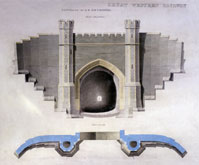
Contractor’s
drawing of Twerton Tunel
drawn to Brunel’s specifications
(Adrian Vaughan Collection)
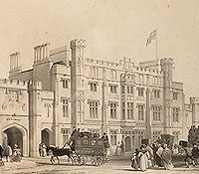
Exterior
of Brunel’s Temple Meads
station at Bristol (National Trust)
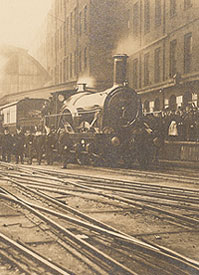
The
last GWR broad gauge locomotive
running from Paddington to Penzance,
1892 (Private collection)

Brunel
sketch of pumping station
for atmospheric railway
(University of Bristol)
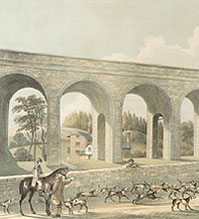
Slade
viaduct on the South Devon
Railway (National Trust)
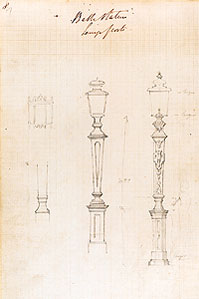
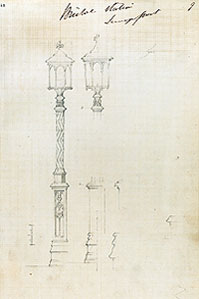
Brunel
sketches of lamp posts at Bath
and Bristol (University of Bristol)
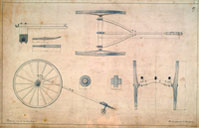

‘ Contractors’
tools designed to Brunel’s
specifications (University of Bristol)
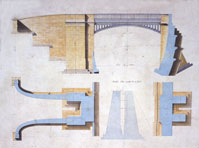
Contractors'
drawing of iron bridge
at Sydney Gardens, Bath
(Adrian Vaughan Collection)
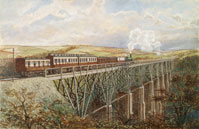
Wooden
viaduct, as used on the
Cornwall and West Cornwall Railways
(Elton Collection: Ironbridge Gorge
Museum
Trust)


During
Brunel’s years in office he became personally involved in every
aspect of the enterprise and insisted on the highest standards of workmanship
throughout. He negotiated with the clients, designed the track layout
and rolling stock, devised radical solutions to civil engineering problems,
secured finance, and recruited, motivated and managed staff. To complete
the survey of the line, Brunel designed a black travelling carriage called
a britzka to carry his drawing board, outline plans, engineering instruments,
50 of his favourite cigars and a pull-out bed.
A private bill was submitted to Parliament in 1834 to allow the
compulsory purchase of land along the chosen route. This was rejected
but a new bill was submitted the following year, with Brunel presenting
GWR’s case. Thanks to his eloquence and enthusiasm, the bill received
Royal Assent on 31 August 1835. Over the next six years, Brunel’s
technical ingenuity was tested by the terrain he crossed and among his
lasting achievements are the bridge at Maidenhead, the viaducts at Hanwell
and Chippenham, and the two-mile-long Box Tunnel. Between the Bath and
Bristol section alone, there are three viaducts, four major bridges and
seven tunnels. Writing of Brunel’s achievement, Kenneth Clark wrote:
Every bridge and every tunnel was a drama, demanding incredible feats
of imagination, energy and persuasion, and producing works of great splendour.
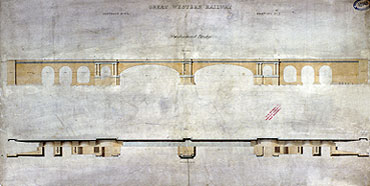
Contractor’s drawing based on Brunel’s
specification for Maidenhead bridge (Adrian Vaughan Collection)
On 30 June 1841 the GWR directors left London on their inaugural
journey down the length of Brunel’s track and arrived in Bristol
only four hours later. From the outset Brunel declared that his route
would be the best but not necessarily the cheapest. The work had cost
£6.5m: more than double the original estimate.
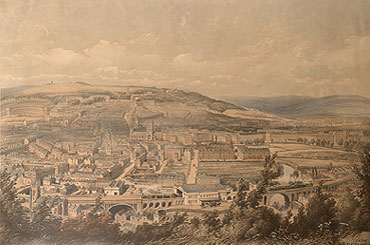
GWR running through Bath to Bristol (National Tust)

Brunel’s sketch for Sydney Gardens, Bath (University
of Bristol)
Brunel was involved in all aspects of the design of the station at Bristol
Temple Meads, one of the oldest surviving railway terminuses in the world,
although it has not been used as such since 1965. At one time the building
housed the Bristol Exploratory hands-on science centre. It currently provides
a home for the British Empire and Commonwealth Museum. Temple Meads is
thought to be the first true ‘terminus’ type of railway station
in which trains and people inhabited the same space beneath a single over-sailing
roof. Some contemporary critics considered the turrets, façades
and decoration were inappropriate and anachronistic, but it is today admired
for the way style, space and structure come together naturally and
coherently. Geoffrey Channon in his account of the promotion of the GWR
has written that opponents to the GWR Bill persistently argued about the
location for the Bristol station:
As generations of tired travellers have observed, the terminus was
chosen on a site which was near to the centre of the ancient city but
not in it... A small sub-committee of three directors examined the matter.
Brunel took them to the top of St Mary Redcliffe Church to survey the
various options. From there it was apparent that Temple Meads was the
only site that had plenty of space to develop depots and other facilities.
Brunel had insisted on using his broad gauge (7ft/2.14m) system instead
of the standard gauge (4ft 8.5/1.43 m) endorsed by Robert and George Stephenson.
This led to difficulties when the two gauges met as passengers had to
transfer trains. With carriages and locomotives designed by Daniel Gooch
to Brunel’s specifications, the broad gauge system was more comfortable
and allowed for faster travel than the narrower gauge. However, in 1846
the government decided in favour of the standard and all new lines were
built to that gauge (the GWR would complete its conversion to standard
in 1892). The government’s decision made economic sense as by that
time 2,000 miles of standard gauge track had been lain compared with only
300 of broad. Unlike the Stephensons, Brunel did not appear to have a
vision of a national rail network using the same gauge: he saw the GWR
as a self-contained route. Writing in his diary, Gooch wrote of the battle
of the gauges:
Were the whole question now open to be decided, the broad gauge is
safer, cheaper, more comfortable, and attains a much higher speed than
the narrow, and would be best for the national gauge. But as the proportion
of broad to narrow is small, there is no doubt the country must submit
to a gradual displacement of the broad, and the day will come when it
will cease. The fight has been of great benefit to the public; it has
pricked on all parties to exertion; the competition of the gauges has
introduction high speeds and great improvements to engines, and was of
great practical use to all those who were actively mixed in the contest,
as they were forced to think and experiment.

Dawn
near Reading, showing a west-bound GWR train c. 1870, artist unkown (Elton
Collection: Ironbridge Gorge Museum
Trust)
Over the next 20 years, the GWR and its associated lines, including the
Bristol and Exeter, South Devon and Cornwall Railways, rapidly spread
throughout the South West, South Wales and Midlands. Part of the South
Devon route was originally designed to be worked by an atmospheric system.
Brunel had thought the system would allow him to adopt stiffer gradients
through the difficult coastal terrain: the developments in the capabilities
of steam locomotives soon made this advantage obsolete. After a series
of trial runs, it was announced at a meeting of shareholders at the Royal
Hotel in Plymouth on 29 August 1848 that the atmospheric system was to
be abandoned.
Through his work on the railway, Brunel contributed to a process that
would come to physically unify the country, conquer distances, widen access
to public transport, and lead to the general adoption of Greenwich Meantime.
By the end of his career it is estimated that Brunel was responsible for
laying nearly 1,200 miles of track including stretches in Italy, Ireland
and Bengal.
As with any project he undertook, Brunel set his personal stamp on the
Great Western Railway. His reluctance to delegate meant every aspect of
the line reflected him as an engineer. Although other railway engineers
may have produced more miles of track and more economically, no other
rail system was so influenced by a single creative genius. Brunel wanted
to build not just the rail route, but the gauge, the engines, the civil
engineering structures and everything else connected to it.
Brunel’s Great Western Railway enhanced the transport and
communication facilities offered by Bristol, and strengthened it as a
regional centre and as a gateway to the South West. Much of the route
Brunel mapped out and the bridges, viaducts, cuttings and tunnels he constructed
continue to be used today. There is a campaign to attain World Heritage
Site status for this route and the ‘pearls’ strung along it
between London and Bristol, including Paddington station, Wharncliffe
Viaduct, the Maidenhead Bridge, Swindon Railway Village, Wootton Bassett
Incline, Box Tunnel, Sydney Gardens and Temple Meads Passenger Shed.

Great Western Railway information leaflet for signalling
systems
(National
Trust)
